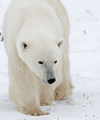Beyond polar bears - finding a new way to communicate climate change

(PhysOrg.com) -- Fear-laden images of a planet in chaos are a real turn off when it comes to changing public perception about climate change, according to research by Newcastle University.
And even the cute, cuddly polar bear icon could have had its day, according to Dr Kate Manzo, who says it’s time for climate change to get a new look.
Her research into climate change communication is published in the current edition of Meteorological Applications and reviews the efforts of journalists, campaigners and politicians to engage the public with the issue against a backdrop of increased scepticism.
Dr Manzo found that many climate change images either make people feel it is inevitable and they cannot do anything to help, or that it is largely irrelevant to them as it is so far into the future.
“The images we see on daily basis can have a dramatic effect on our knowledge and understanding of climate science, our level of concern and ultimately whether we are motivated to take action or not,” she said.
“Different images and framings of climate change work differently and resonate more powerfully with some audiences than others. It is therefore impossible to find a single image which connects with everyone, which is why undue reliance on a limited set of images or framings is problematic.
“Many iconic representations of climate change make it seem far away in time and space and are paradoxical in the way they heighten people’s sense of the issue’s importance while simultaneously making them feel less able to do anything about it,” said Dr Manzo.
“We might think an image is extremely effective because it raises our awareness, but it can be silmutaneously ineffective if it makes us less likely to act upon it.”
Polar bears, the ‘serial killers of the Arctic’, became the rather unlikely cuddly face of climate change, and this is most evident in the story of Knut, the cub from Berlin Zoo whose image was used so successfully for political and commercial campaigns.
“Polar bears score highly in the so called identifiable victim stakes,” said Dr Manzo. “Findings suggest that the image of a lone polar bear - like Knut - wins hands down when it comes to provoking feelings of pity and concern as well as charitable giving.”
However, these standard polar bear images have a limited effect, because even when they raise awareness and elicit emotion they tend to only appeal to people who are wildlife lovers already, with little or no impact outside of this group.
Images of polar bears stranded on ice floes are also indicative of the ‘fear appeals’ which have been shown to prevent meaningful engagement.
Dr Manzo’s research has uncovered a variety of alternative visualisations of climate change as well as substitutes for documentary photography as the dominant visual form of climate change communication.
She suggests that icons of extreme weather and renewable energy are viable alternatives as faces of climate change, with images such as windmills providing an inspirational approach to a climate change message which is inherently difficult to visualise.
Icons of renewable energy have already been used successfully by newspapers and companies such as the Co-op’s advert in 2008 with its crayon drawing of wind turbines accompanied by the caption: ‘We sell over 20 million tins of beans a year. Just as well we have a wind farm.’
Windmills and wind turbines are effective if they change people’s reference point from either business as usual or visions of apocalypse to possible pro-active solutions. The underlying message is simple, effective and encouraging: ‘we’ve done it once and we can do it again’.
“The challenge is to use visuals creatively in ways that can address all three aspects of climate change communications - cognition, affect and behaviour - without enhancing fatalism and disengagement,” said Dr Manzo. “Inspirational alternatives may initially move fewer people, but ultimately they may create a deeper level of engagement with the climate issue, as well as provoking a real commitment to behavioural change.”
More information: Manzo.K, “Beyond polar bears? Re-envisioning climate change,” Meteorological Applications, Wiley-Blackwell, May 2010, DOI: 10.1002/met.193
Provided by Newcastle University















